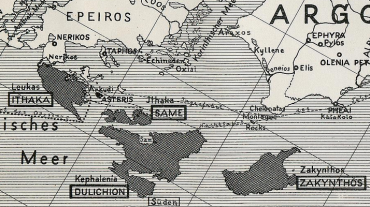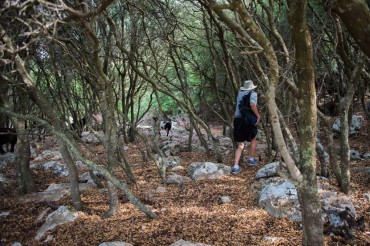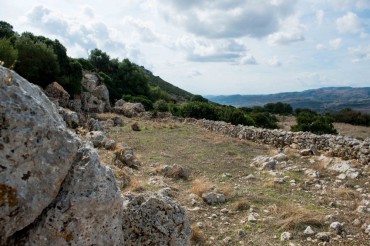Looking for other Ithacas
Once again, our story begins with a bunch of goats monitoring our every moves. Except this time we aren’t trekking on Ithaca, but on the neighboring island of Cephalonia. We are following John Crawshaw, a retired Englishman member of the “Odysseus Unbound” crew. He reaches inside his backpack to get a pair of pliers, and we watch him unwind the rusted barbed wire blocking the access to a dry field. A little further from the grazing goats, we can make out a few ruins. Some say they are the foundations of a structure that appears in the Odyssey: Eumaeus’ piggery house.
While nobody has ever been able to pinpoint where the legendary palace of Odysseus once stood, somebody is bringing us to the famous swineherd’s farm. The very first place the ancient king reached after his ten-year-long journey! «We can of course not yet be certain it is the same place, says our guide, but it fits the description in Homer’s text rather well». Like many of the people we met along our investigation, John Crawshaw is carefully hypothesizing on this subject. Nevertheless, and with a typical British humor, he adds: «Obviously, you have to use your imagination, and replace the goats with pigs…»
«You will find the scene of Odysseus’ wanderings when you find the cobbler who sewed up the bag of winds». Such is the advice, given by Eratosthenes in the third century BC, to all those who fancied locating the legendary palace. In his famous maxim, the Greek geographer and mathematician is referring to the legendary artefact offered by Aeolus, god and Keeper of the winds. A most precious gift for Odysseus, the king who needed all the help he could find to safely sail back home to his wife and son. It’s a solid proof that people have forever been arguing over Homer’s poems. Should we take the geographic descriptions literally? Eratosthenes seemed to think otherwise and scholars have not been listening. The disagreements on ancient Ithaca have been going on since Antiquity.
 Over the decades, historians and archaeologists have advanced many theories. Such as Wilhelm Dörpfeld, who started his career as Heinrich Schliemann’s assistant. While most of his master’s research was focused on Troy and Mycenae, Dörpfeld dedicated his life work to Odysseus’ kingdom. At the beginning of the 20th century, disappointed by the lack of interesting findings on modern Ithaca, he shifted his attention to the island of Lefkada. He was convinced that the forgotten kingdom was finally going to be found close to the little village of Nydri. He spent his last years on the island, and was buried in 1940 close to the ruins that were so important for him. Since then, and for a good reason, many archaeologists have abandoned Dörpfeld’s theories: Lefkada wasn’t an island during the Mycenaean period. Indeed, the canal that separates it from the continent was man-made by the Corinthians during the 5th century BC.
Over the decades, historians and archaeologists have advanced many theories. Such as Wilhelm Dörpfeld, who started his career as Heinrich Schliemann’s assistant. While most of his master’s research was focused on Troy and Mycenae, Dörpfeld dedicated his life work to Odysseus’ kingdom. At the beginning of the 20th century, disappointed by the lack of interesting findings on modern Ithaca, he shifted his attention to the island of Lefkada. He was convinced that the forgotten kingdom was finally going to be found close to the little village of Nydri. He spent his last years on the island, and was buried in 1940 close to the ruins that were so important for him. Since then, and for a good reason, many archaeologists have abandoned Dörpfeld’s theories: Lefkada wasn’t an island during the Mycenaean period. Indeed, the canal that separates it from the continent was man-made by the Corinthians during the 5th century BC.
However, the absence of groundbreaking findings on modern Ithaca isn’t the only reason why archaeologists have lost interest in the island. Homer’s description of the fabled kingdom poses a number of unsolvable problems. Firstly, the boundaries are not consistent whether they are described in the Iliad or the Odyssey. Secondly, the geographic descriptions are contradictory if taken literally. Ithaca is at first pictured as a rather flat island, and later as rocky and not suitable for horseback or carriage travels. As mentioned in the first chapter, Ithaca is supposed to be the last landmass towards the West. A map proves that this is wrong, plain and simple.
Based on these evidences, another enthusiastic British going by the name of Robert Bittlestone came up with a unique theory. In his imposing book “Odysseus Unbound” published in 2005, he places ancient Ithaca on the Paliki peninsula, now connected to the western part of the island of Cephalonia. Unfortunately, Robert Bittlestone died a few months before our investigation in the Ionian islands started. John Crawshaw, a colleague of Bittlestone, who also believes in the potential of Paliki, led us to several of the area’s hotspots.
 Bittlestone and Crawshaw share a similar background, surprisingly lacking a direct connection with history, archaeology or even the study of Homeric texts. They both completed a degree in Classics at the university, which was then followed by a successful career in the private sector. Once retired, they decided to pursue their passion: the uncovering of Odysseus’ mystery. John Crawshaw can’t help but find similarities between his former accomplice and the legendary king of the Ionian Islands: «Robert was a bit like Odysseus. They had the same energy and intelligence in common. They were both leaders, with a contagious curiosity and enthusiasm». Our guide doesn’t tell us if they were also both notorious for their tricks and ruses, and if they shared the same hubris, a Greek concept often linked to Odysseus that symbolizes a violent behavior of extreme pride and arrogance…
Bittlestone and Crawshaw share a similar background, surprisingly lacking a direct connection with history, archaeology or even the study of Homeric texts. They both completed a degree in Classics at the university, which was then followed by a successful career in the private sector. Once retired, they decided to pursue their passion: the uncovering of Odysseus’ mystery. John Crawshaw can’t help but find similarities between his former accomplice and the legendary king of the Ionian Islands: «Robert was a bit like Odysseus. They had the same energy and intelligence in common. They were both leaders, with a contagious curiosity and enthusiasm». Our guide doesn’t tell us if they were also both notorious for their tricks and ruses, and if they shared the same hubris, a Greek concept often linked to Odysseus that symbolizes a violent behavior of extreme pride and arrogance…
The crew of “Odysseus Unbound” defends a theory that was born after John Underhill’s work as a geologist. Underhill studied the nature of the ground where the Paliki peninsula is now connected to the island of Cephalonia. They would like to prove that during the Mycenaean civilization, a canal separated the two lands. Bittlestone also followed the philological research of James Diggle, ancient Greek professor at Cambridge. Promisingly, the core sampling made by Underhill and his crew reveals that water was indeed once present between Cephalonia and Paliki, proving that the latter used to be an island. Although it is still too early to know if it was during the period that interests us, 1’200 years BC.
«We are confident that the area was inhabited during the Mycenaean civilization, Crawshaw explains, because we found graves of that period. We are even able to precisely date them around the time the city of Troy was under siege.” This is an excellent starting point.
 Furthermore, our guide shows us another promising element found in the North of the peninsula, close to the village of Zola and its beach of Agia Kyriaki. «The team found ancient walls that could prove there was a port here during the same Mycenaean period», Crawshaw says.
Furthermore, our guide shows us another promising element found in the North of the peninsula, close to the village of Zola and its beach of Agia Kyriaki. «The team found ancient walls that could prove there was a port here during the same Mycenaean period», Crawshaw says.
However, patience is one of the key components in this kind of business: «We have to follow the rules, and proceed step by step. The first stage is to wait for the geological studies. Once the core samplings will have confirmed our hypothesis, then the archaeologists will be able to start excavating». The British thinks that the project will be launched this year, but is careful not to get his hopes too high. He knows all too well how things work in Greece, where the local red tape and the omnipresent economic crisis slow everything down.
Without waiting for the geologists and archaeologists to reach a conclusion on Paliki, Bittlestone already shares his idea of where the legendary palace once stood. It’s a small hill overlooking the Argostoli bay and opportunistically named “Kastelli”. The remaining ruins that can be observed, as well as the toponymy of the hill all point toward the existence of a fortification. But it’s a long road to knowing if Kastelli was inhabited during the Mycenaean civilization.
 Fortunately, Bittlestone’s death didn’t weigh too much down on the colleagues of “Odysseus Unbound”. In 2016, they plan to achieve all the geological studies, and begin with the administrative procedures, allowing them to focus on the excavation of the spots that correspond to Homer’s texts. «We will keep on searching the Paliki peninsula, we owe it to Robert. His passing drives us to achieve the project he started», says John Crawshaw.
Fortunately, Bittlestone’s death didn’t weigh too much down on the colleagues of “Odysseus Unbound”. In 2016, they plan to achieve all the geological studies, and begin with the administrative procedures, allowing them to focus on the excavation of the spots that correspond to Homer’s texts. «We will keep on searching the Paliki peninsula, we owe it to Robert. His passing drives us to achieve the project he started», says John Crawshaw.
Evidently, the gnashing of teeth on modern Ithaca can almost be heard across the canal. Disputes often occur between the two islands, especially on the topic of King Odysseus. In truth, Homer’s text highlights the long-lasting tensions that exist between the islands of the Ionian Sea. They all belong to the same department and therefore decide together the lists of deputies who will later be defending their interests in Athens. Nontas Mavrokefalos is the general secretary of Ithaca’s communist party, also called KKE today. He deplores this situation : «we are close to 3’000 inhabitants on Ithaca, whereas 35’000 people live on Cephalonia. Neither our interests nor our political colors stand a chance to be represented in Athens.» From Ithaca’s point of view, Cephalonia is in a much better position to receive new infrastructures and archaeological projects. But the economic crisis is the same for everyone, and even Cephalonia is not granted the large excavations related to the Mycenaean period.
 «It is maybe better this way», David Bouvier says maliciously. The Lausanne based professor of ancient Greek believes that «the Odyssey would be amputated from a certain literature dimension and power of imagination if archaeology was able to dissect it very precisely. I have found Ithaca a long time ago… It is in my library!»
«It is maybe better this way», David Bouvier says maliciously. The Lausanne based professor of ancient Greek believes that «the Odyssey would be amputated from a certain literature dimension and power of imagination if archaeology was able to dissect it very precisely. I have found Ithaca a long time ago… It is in my library!»
David Bouvier is one of the few people we met who seems to listen to Eratosthenes. Maybe, he is right. If it’s not in the rocky ground of Ithaca nor in the silty soil of Paliki that we will find the truth on Odysseus and his legend, then where should we look next?




